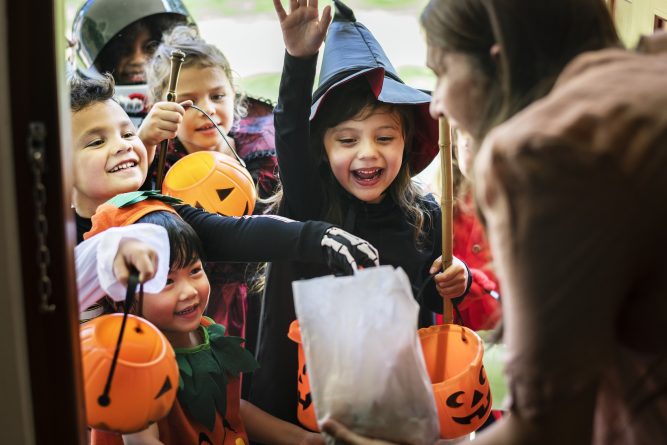Trick-or-treating is a fun and festive Halloween tradition for kids of all ages. While enjoying the evening festivities, safety should be your top priority.
Tips Before You Go
- Choose a safe costume: Make sure your child’s costume fits well and doesn’t restrict their vision or movement. Avoid costumes with long capes or trains, as these can be tripping hazards. Choose costumes made of flame-retardant materials, and avoid masks that could make it difficult for your child to see.
- Plan your route: Talk to your child about the route they’ll be taking, and visit houses that are well-lit and decorated. Avoid taking shortcuts through alleys or deserted areas.
- Make sure your child has a flashlight or glow stick: This will help them see and be seen by drivers. Reflective tape on costumes and candy bags is also best practice.
- Accompany young children: As a best practice, children under the age of 12 should always be accompanied by an adult while trick-or-treating.
- Only go to well-lit and decorated houses. Avoid houses that are dark, boarded up, or not well let. Be aware of your surroundings and watch for traffic.
When You Return
- Inspect all candy: Immediately dispose of candy that is unwrapped, damaged, or discolored.
- Be cautious with homemade candy: While inspecting your child’s candy, take extra precaution for homemade treats, deserts, or custom-packaged handouts.
- Limit your child’s candy intake: Help pace your child by letting them eat a few pieces of candy at a time.
Additional Tips
- Talk to your child about their allergies and restrictions: Make sure they know what they can and cannot eat. Carrying a list of their dietary restrictions may help when speaking with homeowners at their door.
- Be prepared to say no: If a homeowner offers your child candy that they cannot eat due to said restrictions, don’t be afraid to say no.
- Take breaks often: Take breaks often to rest, snack, and hydrate during your outing. Bringing a wagon or stroller is beneficial to help carry supplies.
![NL Wordmark [Gradient] NL Wordmark [Gradient]](https://www.nextlevelurgentcare.com/wp-content/uploads/elementor/thumbs/NL-Wordmark-Gradient-7fm1iv6f0zylwqrxpy8kifrnrzsluqzzzofvqvs6smo.png)
